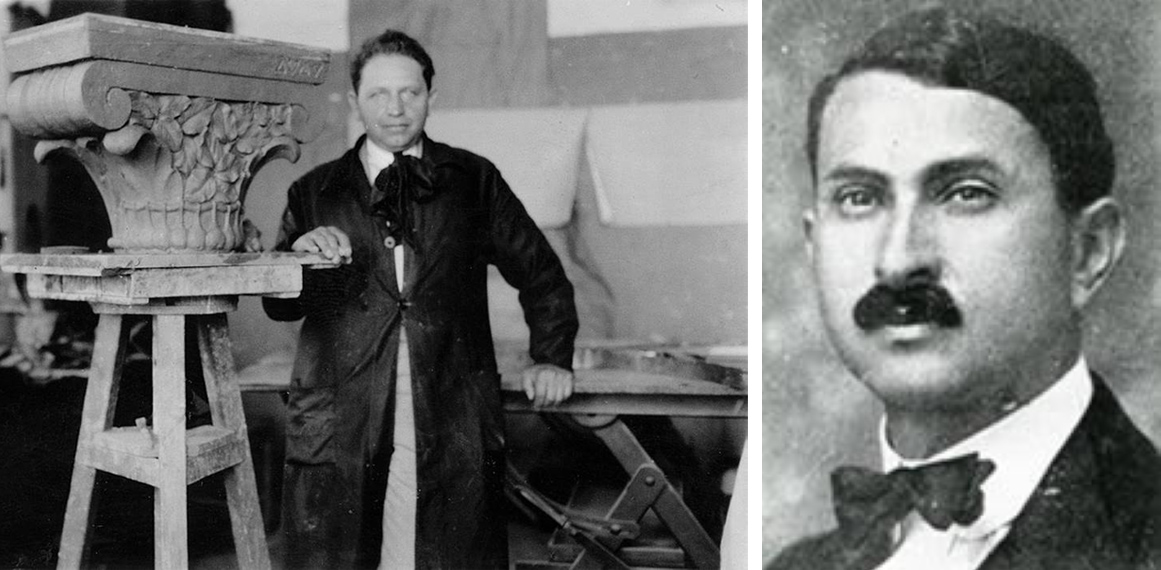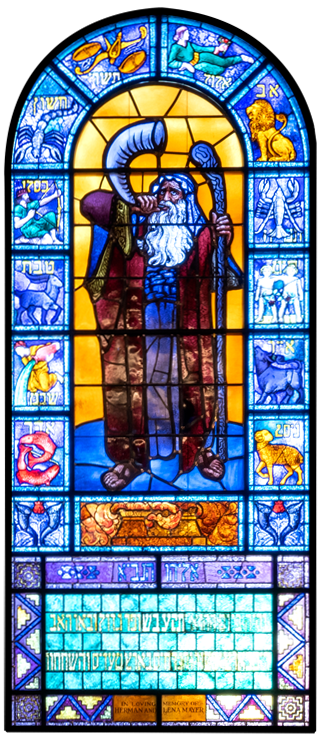SANCTUARY WINDOWS
OF TEMPLE EMANUEL
HISTORY:
SANCTUARY WINDOWS
OF
TEMPLE EMANUEL
HISTORY:
In 1922, Rabbi Samuel Rosinger of Temple Emanuel contacted a young Israeli artist, Ze’ev Raban, offering him the opportunity to design the windows for the new sanctuary building. Raban was 33 years old in 1923 when the 16-foot-high jewels were installed (at a cost of $1,000 each) and was to become a leading Israeli artist, an authority on Marc Chagall, and professor at the prestigious Bezalel School of Art in Jerusalem.
Wrote Rabbi Rosinger: “It was with keen knowledge of Jewish history and pencil and brush handled with appreciation of the best in art that these windows came to be. Each window has a pronounced meaning. Centralized in each design is a single theme. Each panel is at once a delight to the eyes and a study, a liberal education in its particular phase of Bible history.”
In 1922, Rabbi Samuel Rosinger of Temple Emanuel contacted a young Israeli artist, Ze’ev Raban, offering him the opportunity to design the windows for the new sanctuary building. Raban was 33 years old in 1923 when the 16-foot-high jewels were installed (at a cost of $1,000 each) and was to become a leading Israeli artist, an authority on Marc Chagall, and professor at the prestigious Bezalel School of Art in Jerusalem.
Wrote Rabbi Rosinger: “It was with keen knowledge of Jewish history and pencil and brush handled with appreciation of the best in art that these windows came to be. Each window has a pronounced meaning. Centralized in each design is a single theme. Each panel is at once a delight to the eyes and a study, a liberal education in its particular phase of Bible history.”
DESCRIPTION OF EACH OF THE STAINED GLASS WINDOWS:
JEREMIAH WINDOW
I. Jeremiah — On entering the sanctuary through the foyer, the first panel on the north side depicts Jeremiah, prophet of the Temple’s destruction. He sits surrounded by debris from the Temple. Unable to prevent the calamity, unsuccessful at changing the people, he laments: “Would that my head were waters and my eyes a fountain of tears that I might weep day and night for the slaying of the daughters of my people.” (Jeremiah 8:23)
ELIJAH WINDOW
II. Elijah — The center window on the north side shows the prophet Elijah holding a shofar (ram’s horn). Elijah, we are told, will announce the coming of the Messiah by sounding the great and mighty horn. The Hebrew reads: “And on that day, the great horn shall be sounded and they shall come, those who were lost in the land of Assyria, and they that were depressed in the land of Egypt and they shall worship the Lord.” (Isaiah 27:13) The second quotation reads: “Behold, I will send you the prophet Elijah before the coming of the Lord.” (Malachi 3:23) A truly unusual feature unique to this window is the use of the Zodiac symbols surrounding Elijah. They are reminiscent of the ancient mosaic floor unearthed at the synagogue in Bet Alpha, Israel.
ELIJAH WINDOW
II. Elijah — The center window on the north side shows the prophet Elijah holding a shofar (ram’s horn). Elijah, we are told, will announce the coming of the Messiah by sounding the great and mighty horn. The Hebrew reads: “And on that day, the great horn shall be sounded and they shall come, those who were lost in the land of Assyria, and they that were depressed in the land of Egypt and they shall worship the Lord.” (Isaiah 27:13) The second quotation reads: “Behold, I will send you the prophet Elijah before the coming of the Lord.” (Malachi 3:23) A truly unusual feature unique to this window is the use of the Zodiac symbols surrounding Elijah. They are reminiscent of the ancient mosaic floor unearthed at the synagogue in Bet Alpha, Israel.
ELISHA WINDOW
III. Elisha — The third window on the north side depicts the prophet Elisha, successor to Elijah. In the circle is Elijah being carried away heavenward in a chariot with winged horses, driven by an angel of the Lord. Elisha, who witnessed this event, is shown here with Elijah’s mantle of prophecy draped on his shoulders. Elisha cries out, “My Father, my Father, Israel’s chariots and horseman!” (2 Kings 2:12) Then, the Bible tells us that the chariot and the horsemen disappear into the heavens.
EZEKIEL WINDOW
IV. Ezekiel — On the south side of the sanctuary, the panel closest to the bima shows the great prophet Ezekiel in a trance as he receives his revelation. The outstretched hand is God’s, offering Ezekiel the scroll upon which is written his prophetic message. The Hebrew reads: “Son of Man, I have made you a watchman over Israel.” (Ezekiel 3:17) In the circle is God’s throne being carried by the creature envisioned in Ezekiel’s dream. It had four faces and sides giving the appearance of a man, an ox, an eagle, and a lion.
The Hebrew reads: “And when I looked, behold, a hand was put forth to me, holding a scroll; and God spread it before me, and it was written within and without; and there was written on it lamentations, moaning and woe.” (Ezekiel 2:9-10)
EZEKIEL WINDOW
IV. Ezekiel — On the south side of the sanctuary, the panel closest to the bima shows the great prophet Ezekiel in a trance as he receives his revelation. The outstretched hand is God’s, offering Ezekiel the scroll upon which is written his prophetic message. The Hebrew reads: “Son of Man, I have made you a watchman over Israel.” (Ezekiel 3:17) In the circle is God’s throne being carried by the creature envisioned in Ezekiel’s dream. It had four faces and sides giving the appearance of a man, an ox, an eagle, and a lion.
The Hebrew reads: “And when I looked, behold, a hand was put forth to me, holding a scroll; and God spread it before me, and it was written within and without; and there was written on it lamentations, moaning and woe.” (Ezekiel 2:9-10)
MOSES WINDOW
V. Moses — The center window on the south side shows Moses, Israel’s chief lawgiver. Above his head are the two tablets of the Ten Commandments. Beginning with the rising sun on the right side, are the symbols of the twelve tribes of Israel — Reuben, Simeon, Judah, Issachar, Zebulun, Benjamin, Dan, Naphtali, Gad, Asher, Manasseh, and Ephraim. The Hebrew reads: “The Law which Moses commanded us is a heritage unto the House of Jacob.” (Deuteronomy 33:4)
ISAIAH WINDOW
VI. Isaiah — The panel closest to the foyer on the south side presents Isaiah and his message of universal peace. It is as significant and hope-filled a statement now as it was in the 6th century B.C.E. “Let the time come when the wolf shall dwell with the lamb and the leopard will lie down with the kid and calf, the young lion and the fatling together and a little child shall lead them.” (Isaiah 11:6)
ISAIAH WINDOW
VI. Isaiah — The panel closest to the foyer on the south side presents Isaiah and his message of universal peace. It is as significant and hope-filled a statement now as it was in the 6th century B.C.E. “Let the time come when the wolf shall dwell with the lamb and the leopard will lie down with the kid and calf, the young lion and the fatling together and a little child shall lead them.” (Isaiah 11:6)









